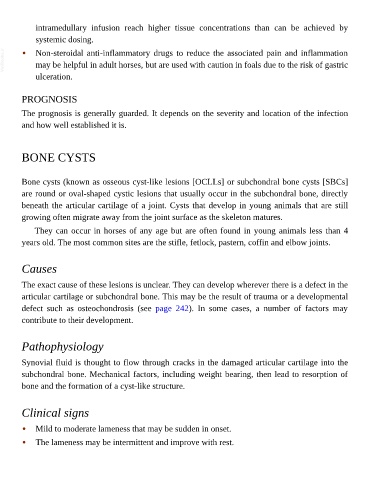Page 461 - The Veterinary Care of the Horse
P. 461
intramedullary infusion reach higher tissue concentrations than can be achieved by
systemic dosing.
VetBooks.ir • Non-steroidal anti-inflammatory drugs to reduce the associated pain and inflammation
may be helpful in adult horses, but are used with caution in foals due to the risk of gastric
ulceration.
PROGNOSIS
The prognosis is generally guarded. It depends on the severity and location of the infection
and how well established it is.
BONE CYSTS
Bone cysts (known as osseous cyst-like lesions [OCLLs] or subchondral bone cysts [SBCs]
are round or oval-shaped cystic lesions that usually occur in the subchondral bone, directly
beneath the articular cartilage of a joint. Cysts that develop in young animals that are still
growing often migrate away from the joint surface as the skeleton matures.
They can occur in horses of any age but are often found in young animals less than 4
years old. The most common sites are the stifle, fetlock, pastern, coffin and elbow joints.
Causes
The exact cause of these lesions is unclear. They can develop wherever there is a defect in the
articular cartilage or subchondral bone. This may be the result of trauma or a developmental
defect such as osteochondrosis (see page 242). In some cases, a number of factors may
contribute to their development.
Pathophysiology
Synovial fluid is thought to flow through cracks in the damaged articular cartilage into the
subchondral bone. Mechanical factors, including weight bearing, then lead to resorption of
bone and the formation of a cyst-like structure.
Clinical signs
• Mild to moderate lameness that may be sudden in onset.
• The lameness may be intermittent and improve with rest.

